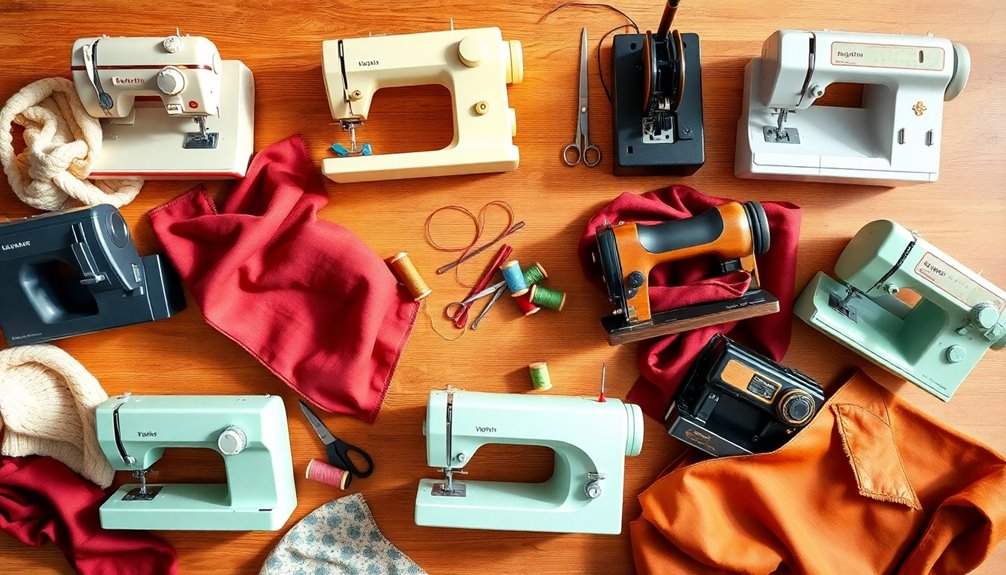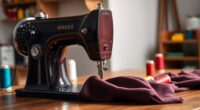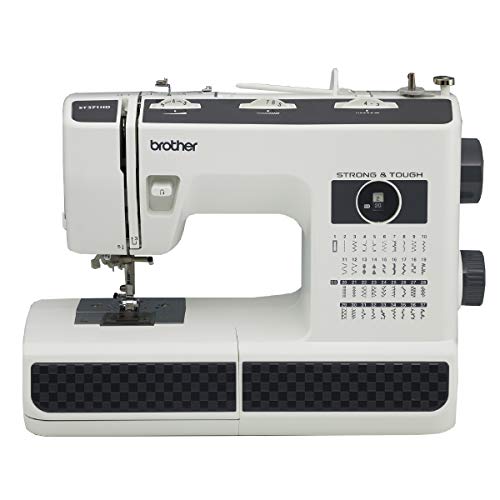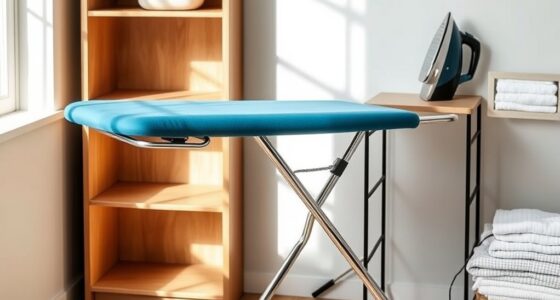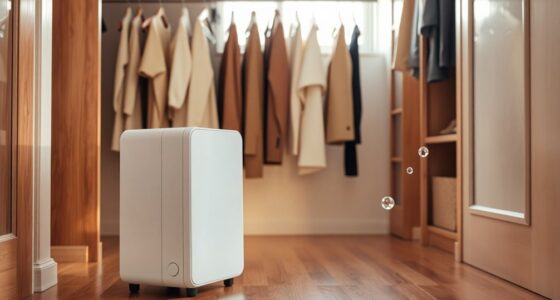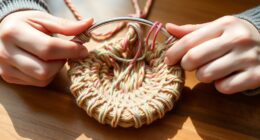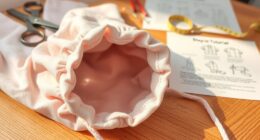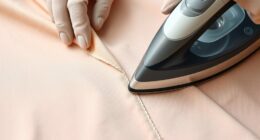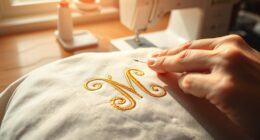I’ve explored the 15 best sewing machines for fabric and leather projects, focusing on performance, durability, and ease of use. Machines like the SINGER Heavy Duty series and specialized leather sewing machines stand out for their speed and stitch versatility. If you’re a beginner or need something portable, options like the Dechow Electric Mini are perfect. To help you make the best choice, I’ll guide you through each machine’s features and applications. Additionally, if you’re looking for specialized functionality, some of the best sewing machines for leather boast higher horsepower motors that tackle thicker materials with ease. Models equipped with walking feet are particularly advantageous, as they help maintain even feeding and prevent slipping. As you evaluate your options, consider not only the projects you’ll undertake but also the machine’s maintenance requirements to ensure longevity and consistent performance.
Key Takeaways
- The SINGER Heavy Duty series offers high speed and durability, making them ideal for both fabric and leather projects.
- Beginner-friendly options like the Brother XM2701 provide versatile stitching capabilities for light to medium fabrics, perfect for new sewers.
- Machines with strong motors, such as the Leather Sewing Machine, excel in handling thick materials and reducing sewing time.
- Consider features like stitch variety and ease of use, which enhance functionality for different sewing projects and skill levels.
- Regular maintenance and a full metal frame are crucial for ensuring long-term performance and durability in sewing machines.
SINGER Heavy Duty 4432 Sewing Machine
If you're looking for a sewing machine that can handle everything from delicate fabrics to heavy leather, the SINGER Heavy Duty 4432 is your best bet. This machine's heavy metal frame guarantees stability, while its impressive speed of up to 1,100 stitches per minute makes sewing a breeze. With 110 stitch applications and an easy-to-use top drop-in bobbin, I find it perfect for both beginners and seasoned sewers. The built-in reverse lever and one-step buttonhole feature add convenience, too. Users rave about its reliability and stitching quality, making it a fantastic choice for anyone serious about their sewing projects.
Best For: The SINGER Heavy Duty 4432 is best for both beginners and experienced sewers looking for a reliable, high-speed sewing machine that can handle a wide range of fabrics and projects.
Pros:
- Heavy metal construction ensures durability and stability during use.
- High sewing speed of up to 1,100 stitches per minute allows for quick and efficient sewing.
- User-friendly features like the top drop-in bobbin and built-in reverse lever enhance convenience and ease of use.
Cons:
- May be considered heavy and less portable compared to plastic-framed machines.
- Some users might find the learning curve steep for advanced features.
- Limited advanced settings may not satisfy professional sewists looking for intricate customization.
SINGER Heavy Duty 4432 Sewing Machine with Accessory Kit
The SINGER Heavy Duty 4432 Sewing Machine with Accessory Kit is perfect for anyone tackling fabric and leather projects, thanks to its impressive ability to sew up to 1,100 stitches per minute. I love the enhanced piercing power, which effortlessly handles multiple layers and thick fabrics like denim. With 110 stitch options, including decorative and stretch stitches, I find it versatile for any project. The top drop-in bobbin is easy to monitor, and the built-in needle threader saves time. While I appreciate the sturdy metal frame, I wish there were clearer instructions to navigate all the accessories. Overall, it's a reliable machine!
Best For: The SINGER Heavy Duty 4432 Sewing Machine is best for beginners and experienced sewists looking for a reliable machine that can handle thick fabrics and various sewing projects.
Pros:
- High speed of up to 1,100 stitches per minute, making it efficient for larger projects.
- Versatile stitch options with 110 different stitches, suitable for basic, decorative, and stretch needs.
- Durable metal frame that provides stability and longevity during use.
Cons:
- Lack of printed instruction manual, which may hinder new users from fully understanding all features.
- Troubleshooting difficulties, particularly with the bobbin case and threading, reported by some users.
- Quality control issues, leading to frustrations with machine performance and refund processes.
Leather Sewing Machine for Thick Material
For those tackling heavy-duty leather projects, the Leather Sewing Machine from YWXFSS is a game changer. With a remarkable speed of 3000 stitches per minute, it easily handles thick materials like leather and canvas. The adjustable thread gripper guarantees tight stitches, preventing breakage during intense sewing sessions. I love the versatile stitch control, allowing me to customize lengths up to 0.3 inches. Its automatic lubrication feature keeps everything running smoothly and quietly. Weighing around 66.8 pounds, this robust machine is built to last, making it my go-to choice for any serious leatherwork I take on.
Best For: The Leather Sewing Machine is best for professional leatherworkers and hobbyists who require a reliable tool for heavy-duty sewing tasks involving thick materials.
Pros:
- High Speed: Capable of sewing at 3000 stitches per minute, enhancing productivity for large projects.
- Versatile Stitch Control: Adjustable stitch length allows customization for various sewing needs, up to 0.3 inches.
- Automatic Lubrication: Integrated oil spraying device ensures smooth operation and reduces noise during use.
Cons:
- Weight: At 66.8 pounds, it may be difficult to move or transport for some users.
- Motor and Table Sold Separately: Additional purchases are required to fully utilize the machine, increasing initial investment.
- Complexity for Beginners: The advanced features may be overwhelming for novice users unfamiliar with heavy-duty sewing machines.
SINGER Heavy Duty 500 Classic Sewing Machine
Whether you're tackling heavy fabrics like denim or leather, the SINGER Heavy Duty 500 Classic Sewing Machine stands out as an exceptional choice. I love its vintage-inspired design that adds charm to my sewing space while offering modern features like a built-in needle threader and one-step buttonhole. The powerful motor delivers impressive performance, effortlessly piercing through thick materials. Plus, the customizable stitch settings let me adjust for precision in various projects. Although it has a few plastic components, its full metal frame guarantees durability. With a solid accessory kit, I felt ready to sew right away, despite a minor learning curve.
Best For: The SINGER Heavy Duty 500 Classic Sewing Machine is best for sewists seeking a reliable machine capable of handling heavy fabrics with a vintage aesthetic.
Pros:
- Powerful motor offers 50% more power than standard models, making it ideal for sewing thick materials like denim and leather.
- Customizable stitch settings allow for precision in various sewing techniques, enhancing versatility for different projects.
- Comprehensive accessory kit provides all necessary tools to start sewing immediately, making it user-friendly for beginners.
Cons:
- Some components, like the presser foot lever, are made of plastic, raising concerns about long-term durability.
- Users may experience a learning curve with threading and bobbin winding, which can be challenging for beginners.
- The lack of a printed manual could inconvenience those who prefer physical instructions, though an online version is available.
SINGER Heavy Duty 4452 High Speed Sewing Machine
Looking for a sewing machine that can handle both thick fabrics and delicate materials with ease? The SINGER Heavy Duty 4452 is an absolute powerhouse. With its strong motor and impressive piercing power, it effortlessly sews through multiple layers. I love the 110 stitch applications, including a one-step buttonhole, which makes my projects versatile. The top drop-in bobbin and built-in needle threader simplify setup. Plus, its full metal frame guarantees durability during intense sessions. Whether you're a beginner or a pro, this reliable machine provides the flexibility you need, although be cautious of the upright spool pin to avoid thread jams.
Best For: The SINGER Heavy Duty 4452 is best for both beginners and experienced sewists looking for a reliable, versatile sewing machine that can handle a wide range of fabrics.
Pros:
- Excellent performance on various fabrics, from thick denim to delicate materials.
- User-friendly features such as a built-in needle threader and top drop-in bobbin for easy setup.
- Sturdy full metal frame provides stability and durability during intense sewing sessions.
Cons:
- The upright spool pin may cause thread jams for some users, requiring alternative thread management solutions.
- Requires regular cleaning and oiling to maintain optimal performance.
- Voltage compatibility issues may arise when purchasing internationally, necessitating verification before use.
SINGER Heavy Duty 4411 High Speed Sewing Machine
The SINGER Heavy Duty 4411 High Speed Sewing Machine stands out for its impressive power, making it an excellent choice for anyone tackling tough fabrics like denim, canvas, and leather. With a motor that offers 50% more power, I found it effortlessly handles thick seams with a smooth operation. Its ability to stitch up to 1,100 stitches per minute is a game-changer for everyday repairs and complex projects alike. The user-friendly design, including quick-threading guides and an adjustable stitch length, made my sewing experience enjoyable. Overall, this machine delivers reliability and value, making it a fantastic investment for both beginners and experienced sewists.
Best For: The SINGER Heavy Duty 4411 is best for both beginners and experienced sewists who want a reliable machine for handling tough fabrics like denim and leather.
Pros:
- Powerful motor provides 50% more strength for tackling heavy materials effortlessly.
- High-speed stitching capability of up to 1,100 stitches per minute enhances efficiency for both simple and complex projects.
- User-friendly features such as quick-threading guides and adjustable stitch settings promote an enjoyable sewing experience.
Cons:
- Limited advanced features may not satisfy users looking for computerized options or extensive stitch patterns.
- Weight could be a disadvantage for those needing a portable sewing machine.
- Warranty limitations may not cover all types of damage, which could lead to potential repair costs.
Cobbler Sewing Machine for Leather and Fabrics
For those who tackle both leather and fabric projects, the 2021 Cobbler Sewing Machine stands out with its ability to handle a maximum sewing thickness of 0.48 inches. Its stainless steel base and 110V, 250W motor provide decent power, though I've found assembly tricky due to mismatched bolt holes and unclear instructions. The upgraded design reduces friction, which helps with smooth operation, yet it requires regular maintenance and different needle sizes for various materials. While it's great for leather, beginners may struggle with motor control and setup. Overall, it's a unique, affordable option if you're willing to put in some extra effort.
Best For: Those with some mechanical inclination looking to sew both leather and fabric projects effectively.
Pros:
- Affordable option for sewing thick materials like leather.
- Upgraded design reduces friction, enhancing smooth operation.
- Maximum sewing thickness of 0.48 inches accommodates a variety of projects.
Cons:
- Assembly can be difficult due to mismatched bolt holes and unclear instructions.
- High maintenance required with frequent oiling to prevent rust.
- Motor control issues reported, which can hinder precision sewing, especially for beginners.
Brother ST371HD Sewing Machine with 37 Built-in Stitches
If you're seeking a reliable sewing machine that effortlessly handles both fabric and leather projects, the Brother ST371HD is an excellent choice. With 37 built-in stitches, including an auto-size buttonhole, it offers versatility for any project. I love the automatic needle threader and the jam-resistant drop-in top bobbin, which make sewing smooth and hassle-free. It even boasts a maximum speed of 800 stitches per minute! The free arm feature is perfect for cuffs and sleeves, while the included accessories, like multiple sewing feet, guarantee I'm always prepared. Plus, it's backed by a solid 25-year warranty for peace of mind.
Best For: Those who want a durable and versatile sewing machine suitable for both beginners and advanced users, capable of handling various fabrics including thicker materials.
Pros:
- Versatile: 37 built-in stitches, including an auto-size buttonhole, provide a wide range of options for different sewing projects.
- User-Friendly: Features like the automatic needle threader and jam-resistant drop-in top bobbin simplify the sewing process.
- Durable Construction: Designed to handle heavy fabrics, making it suitable for a variety of projects, from clothing to home décor.
Cons:
- Buttonhole Attachment Adjustment: Some users have reported minor difficulties in adjusting the buttonhole attachment.
- Pedal Issues: A few customers have experienced problems with the sewing pedal.
- Weight: At 18.4 pounds, it may be less portable compared to lighter models.
Xuthusman Electric Sewing Machine for Leather and Canvas
Looking for a reliable sewing machine that tackles both leather and canvas with ease? The Xuthusman Electric Sewing Machine, model GK9-890, is a powerhouse with a 190W motor, delivering up to 1,800 stitches per minute. It handles materials up to 6mm thick, making it perfect for various projects. I appreciate its two cutting modes and adjustable thread spacing, enhancing efficiency. Plus, the insulated handle guarantees comfortable operation. With a lightweight design and durable metal construction, it's ideal for both personal and professional use. Whether you're sealing bags or crafting leather goods, this machine won't let you down.
Best For: Ideal for express logistics companies, large factory warehouses, and hobbyists seeking a reliable machine for leather and canvas projects.
Pros:
- High Speed: Capable of sewing up to 1,800 stitches per minute, enhancing productivity.
- Versatile Applications: Suitable for a variety of materials, including leather, canvas, and various types of bags.
- User-Friendly Design: Features an insulated, anti-slip handle and adjustable thread spacing for comfortable and efficient operation.
Cons:
- Weight: At 3.9kg (8.5lbs), it may be heavier than some users prefer for portable projects.
- Limited Warranty Information: Warranty details are not readily available, which may concern potential buyers.
- Power Requirement: Operates at 110V, which may not be suitable in regions with different voltage standards.
Brother SE700 Embroidery & Sewing Machine with Starter Bundle
The Brother SE700 Embroidery & Sewing Machine with Starter Bundle stands out for its impressive built-in features, making it an ideal choice for both novice and experienced crafters. With 135 embroidery designs, 103 sewing stitches, and a user-friendly 3.7-inch LCD touchscreen, I found it easy to navigate my projects. The auto needle threader and jam-resistant bobbin save me time, while the wireless connectivity allows for seamless design transfers. Plus, the included starter bundle enhances my crafting experience greatly. Overall, it's a versatile machine that balances functionality and creativity, making it a solid investment for anyone passionate about sewing and embroidery.
Best For: The Brother SE700 Embroidery & Sewing Machine is best for both beginner and experienced crafters looking for a versatile machine that combines sewing and embroidery capabilities in one.
Pros:
- User-friendly touchscreen allows for easy navigation and project management.
- Wide range of built-in designs and stitches provides ample creative options for various projects.
- Starter bundle includes essential tools and supplies, enhancing the overall crafting experience.
Cons:
- Some users report mixed experiences with sewing accuracy and thread compatibility.
- Instructions for use may be lacking in clarity, leading to a learning curve for new users.
- The Artspira App requires a subscription for full functionality, which may be a drawback for some users.
Sewing Machine for Beginners, Electric Mini Portable
For anyone just starting their sewing journey, the Dechow Electric Mini Portable Sewing Machine stands out as an ideal choice. Weighing only 5.1 pounds, it's lightweight and easily transportable, perfect for on-the-go projects. With 14 built-in stitches and two speeds, this machine offers versatility while ensuring safety for beginners. I love the double thread feature, which creates stronger seams without the hassle of tying. Plus, it includes handy accessories like a foldable storage bag and colorful threads. While it's great for light fabrics, be cautious with heavy layers. Overall, it's a fantastic introduction to sewing for kids and adults alike!
Best For: The Dechow Electric Mini Portable Sewing Machine is best for beginners and children looking to explore the art of sewing.
Pros:
- Lightweight and portable, making it easy to carry for on-the-go projects.
- User-friendly design with adjustable speed settings and built-in sewing light for better visibility.
- Versatile capabilities with 14 built-in stitches suitable for various sewing projects.
Cons:
- May struggle with multiple layers of heavy fabrics, such as denim.
- Some users have noted concerns about the durability of the foot pedal.
- The machine can be noisy during operation, which might be distracting.
Brother XM2701 Sewing Machine
Engineered with beginners in mind, the Brother XM2701 Sewing Machine offers a lightweight, full-featured design that makes it an ideal choice for anyone venturing into fabric and leather projects. With 27 unique built-in stitches, including decorative and auto-size buttonhole options, I found it incredibly versatile. The automatic needle threader and jam-resistant drop-in bobbin simplify my sewing tasks. Plus, the free arm is perfect for tackling cuffs and sleeves. I appreciate the included instructional DVD, which makes learning a breeze. With a solid warranty and reliable customer support, it's no wonder this machine enjoys high ratings from users like me!
Best For: Beginners and intermediate users looking for a lightweight sewing machine with versatile features for various projects.
Pros:
- User-friendly design makes it easy for beginners to learn sewing.
- Versatile options with 27 built-in stitches for different sewing needs.
- Automatic features like needle threading and bobbin winding streamline the sewing process.
Cons:
- Limited to light to medium fabrics, may struggle with heavier materials like denim.
- Intended for use in the US only, which may limit international buyers.
- Some users may find the weight (12.6 pounds) a bit cumbersome for portability.
Leather Sewing Machine for Shoe and Bag Repair
When it comes to repairing shoes and bags, finding a reliable sewing machine can feel overwhelming. I recently discovered the FAHKNS Leather Sewing Machine, and it's been a game changer. Weighing just 11.05 pounds, it's portable and made from durable aluminum alloy. It handles thick materials effortlessly, with a stitch thickness of up to 0.24 inches. The dual cotton and nylon line feature makes it versatile for various projects, from high heels to leather bags. Plus, it's easy to assemble and maintain. With customer ratings around 4 stars, it's a solid choice for anyone tackling leather repairs.
Best For: Those seeking a reliable and portable sewing machine for leather repairs on shoes and bags.
Pros:
- Durable construction with aluminum alloy ensures long-lasting use.
- Versatile capabilities allow for sewing various materials, including leather, nylon, and cotton.
- Compact and portable design makes it easy to store and transport.
Cons:
- Requires regular maintenance such as oiling movable parts for optimal performance.
- May have a learning curve for beginners unfamiliar with sewing machines.
- Customer ratings suggest mixed experiences with assembly and initial setup.
Brother ST150HDH Sewing Machine
The Brother ST150HDH Sewing Machine stands out with its impressive ability to tackle multiple layers of heavyweight fabrics, making it an excellent choice for anyone tackling both fabric and leather projects. With 50 built-in stitches and 5 auto-size buttonholes, I found it versatile for various tasks. The LCD screen simplifies stitch selection, while the variable speed control gives me precise handling over my projects. Weighing just over 10 pounds, it's portable yet sturdy. Plus, the included accessories, like multiple sewing feet, enhance my sewing experience. Overall, it's reliable, user-friendly, and perfect for both beginners and seasoned sewers.
Best For: The Brother ST150HDH Sewing Machine is best for both beginners and experienced sewers who need a reliable and versatile machine for various fabric types and sewing projects.
Pros:
- Versatile with 50 built-in stitches and 5 auto-size buttonholes, accommodating a wide range of sewing tasks.
- Excellent performance with heavyweight fabrics, making it suitable for projects like denim and upholstery.
- User-friendly features, including an LCD screen and variable speed control for precise handling.
Cons:
- Some users have reported that the LED light is dim, which can affect visibility while sewing.
- The plastic throat plate has received minor critiques regarding durability compared to metal options.
- Threading instructions in the manual could be clearer, causing some initial confusion for users.
Handheld Mini Portable Electric Sewing Machine
If you're someone who loves tackling quick sewing tasks on the go, the handheld mini portable electric sewing machine is an ideal companion. It's lightweight, compact, and ergonomically designed, making it perfect for home or travel. You can power it with AA batteries or plug it in for convenience. I love how it handles a variety of fabrics, from clothing to curtains, making it user-friendly for beginners and kids alike. Plus, it comes with a complete toolkit, so you're ready to sew right away. With a solid 4.8-star rating, it's a practical gift for anyone with small sewing needs.
Best For: Individuals seeking a portable and easy-to-use sewing solution for quick repairs and DIY projects.
Pros:
- Lightweight and compact design makes it easy to carry for travel and home use.
- Versatile for various fabrics, accommodating everything from clothing to curtains.
- Complete toolkit included, ensuring you have everything needed to start sewing right away.
Cons:
- Power options may require additional purchases, as batteries and charging cable are not included.
- Limited to small sewing tasks, may not be suitable for larger projects or heavy-duty fabrics.
- May lack advanced features found in more traditional sewing machines, limiting its functionality for experienced users.
Factors to Consider When Choosing a Sewing Machine for Fabric and Leather Projects Reviews

When I'm choosing a sewing machine for both fabric and leather projects, I think about several key factors. Fabric compatibility, stitch variety, motor power, durability, and ease of use all play a huge role in my decision-making process. Let's break these down so you can find the perfect machine for your needs.
Fabric Compatibility
Choosing the right sewing machine for fabric and leather projects can make all the difference in your crafting experience. When I look for a machine, I always check its ability to handle different fabric weights. Not every machine can sew through heavy materials like denim or leather efficiently. I recommend finding one with a powerful motor and enhanced piercing power to tackle multiple layers without strain. A top drop-in bobbin system and an automatic needle threader are real time-savers, especially with thicker fabrics. Plus, using the right needles—like heavy-duty or leather ones—is essential for peak performance. With these factors in mind, you'll guarantee your machine meets the demands of both fabric and leather projects.
Stitch Variety
Having a diverse stitch variety is essential for tackling various fabric and leather projects effectively. I love that many machines offer between 69 to 110 stitch applications, giving me the flexibility to choose the right stitch for tasks like quilting or garment construction. The one-step buttonhole feature is a game changer, allowing me to create consistent buttonholes effortlessly. Plus, the ability to adjust stitch length and width lets me customize stitches for everything from lightweight fabrics to heavy leather. For heavy-duty projects, I appreciate machines that include specialized stitches designed for thicker materials, ensuring strong seams and durability. This versatility not only enhances my creativity but also improves the overall quality of my finished projects.
Motor Power
As I immerse myself in selecting a sewing machine, motor power stands out as an vital factor, especially for fabric and leather projects. A stronger motor enhances piercing power for thicker materials like denim and leather, making it easier to sew through multiple layers. I've found that machines with motors rated for 50% more power than standard models excel in heavy-duty tasks, providing smoother operation. High-speed machines, capable of reaching 3,000 stitches per minute, are perfect for larger projects and can greatly reduce sewing time. Additionally, a robust motor guarantees consistent performance and minimizes the risk of skipped stitches on challenging materials. Overall, investing in a machine with ample motor power is imperative for achieving great results in my sewing endeavors.
Durability and Construction
Durability and construction are fundamental elements when I evaluate sewing machines for fabric and leather projects. I prefer machines with a full metal frame, as they provide stability and longevity, allowing for high-speed performance. Heavy-duty options often feature powerful motors that can penetrate thick materials like denim and leather, which is essential for my projects. I always consider the quality of materials used; high-density components typically withstand intense use better than plastic ones. User feedback consistently highlights that robust build quality is critical for reliability. To keep my durable sewing machine running smoothly, I make certain to perform regular maintenance, like cleaning and oiling its mechanical parts. This way, I guarantee it operates effectively over time.
Ease of Use
When it comes to choosing a sewing machine for fabric and leather projects, ease of use is a top priority for me. I find that user-friendly features, like automatic needle threaders and jam-resistant bobbins, really make a difference, whether you're a beginner or an experienced sewist. Clear threading instructions and a simple stitch selection dial help me set up quickly, which is essential for a smoother learning process. I also love machines with top drop-in bobbins and transparent covers; they let me monitor thread levels easily. Intuitive elements like adjustable stitch length and width allow me to customize my sewing without hassle. Plus, lightweight and portable machines make it easier to sew anywhere I want!
Price and Value
Understanding the balance between price and value is essential for anyone selecting a sewing machine for fabric and leather projects. When I consider price, I always evaluate the machine's features and capabilities. Higher-priced models often come with advanced functionalities that can handle thicker fabrics and complex tasks, making them worth the investment. While budget-friendly machines might work for light projects, they may not offer the same longevity or performance. I also look for machines with a warranty, as this adds value by protecting against defects. Plus, many machines come with accessory kits, enhancing versatility. Finally, I always check user reviews to guarantee the price aligns with performance and reliability, highlighting the true value of my investment.
Maintenance Requirements
While I know that choosing a sewing machine often focuses on features and price, maintenance requirements shouldn't be overlooked. Regular cleaning and oiling are essential, especially for machines tackling heavy fabrics and leather, as they can collect lint and debris quickly. I've found that mechanical models tend to be easier to maintain than electronic ones due to fewer complex parts. It's important to check and replace needles frequently when working with thicker materials to avoid damaging the machine. Keeping the bobbin area clean and ensuring proper threading can help prevent frustrating issues like thread jams. Always consult the user manual for specific maintenance guidelines tailored to your machine's design and intended use, as this can greatly impact its longevity and performance.
Frequently Asked Questions
Can I Use a Standard Sewing Machine for Leather Projects?
I often get asked if a standard sewing machine can handle leather projects. The truth is, it can, but it depends on the thickness of the leather and the machine's capabilities. I've used my regular machine for lighter leather, and it worked fine with the right needle and foot. However, for thicker leather, you might want to invest in a heavy-duty machine to avoid any issues. Always test on scraps first!
What Types of Needles Are Best for Sewing Leather?
When it comes to sewing leather, you'll want needles that practically slice through it like butter! I've found that using a leather needle, which has a wedge-shaped point, works wonders. It pierces the material without damaging it. Another great option is a heavy-duty needle, perfect for thicker leather. Trust me, using the right needle makes all the difference, ensuring your project turns out beautifully without any frustrating snags.
How Do I Maintain My Sewing Machine for Leather Sewing?
Maintaining my sewing machine for leather sewing is essential. I regularly clean the feed dogs and remove any dust or debris. I also oil the machine according to the manufacturer's instructions, especially around the moving parts. I change the needle frequently, using one designed for leather, to guarantee smooth stitching. Finally, I keep an eye on the tension settings, adjusting them as needed for different leather thicknesses. This way, my projects turn out beautifully!
Are There Special Presser Feet for Leather Sewing?
Yes, there are special presser feet for leather sewing! I've found that using a walking foot or a Teflon foot makes a huge difference when working with leather. These feet help glide over the material smoothly, preventing sticking and uneven stitches. I've also used an edge guide foot for precise stitching along edges. Investing in the right presser feet has definitely improved my leather projects and made the sewing process much easier.
Can I Sew Multiple Layers of Fabric With These Machines?
Did you know that about 70% of sewing enthusiasts struggle with multiple layers of fabric? I've faced this challenge myself! Most sewing machines can handle several layers if they're designed for it. I've found that models with strong motors and adjustable presser feet work best. They glide through thick materials effortlessly. So, if you're planning to sew multiple layers, look for a machine that offers those features, and you won't be disappointed!
Conclusion
In choosing the right sewing machine for your fabric and leather projects, it's essential to take into account your needs and preferences. Whether you're stitching together a cozy quilt or repairing a beloved leather bag, the right machine can make all the difference. Isn't it exciting to think about the beautiful creations you can bring to life? With the options we've explored, you're well on your way to finding the perfect companion for your sewing journey. Happy sewing!
